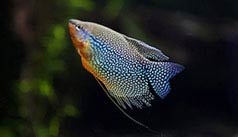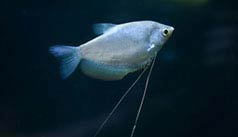

Blue Gourami
(Trichogaster trichopterus)
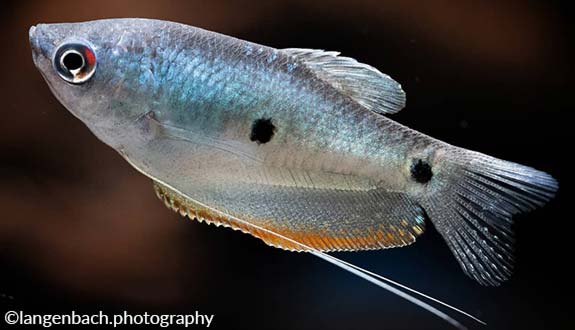
Many thanks to Kyllian!
Alternative species (click on the thumbnail to see the card)
Names
Scientific name
Trichogaster trichopterus
Common name
Blue Gourami Three-spot Gourami
Gold Gourami (albino)
Origin

Origin: Thailand, Burma, Vietnam, Malaysia, Indonesia
Biotope: Asian
Dimorphism

The dorsal male is elongated and pointed, unlike that of the female, which is short and rounded
Group

Osphronemidae
Volume

200 L / 44 imp gal / 53 US gal
Parameters

T°: 22 to 28°C or 72 to 82°F
pH: 6 to 8.5
Hardness: 5 to 16°dGH
Difficulty

Easy
Size

9 to 15 cm (3.5 to 5.9")
Longevity

10 years
Living zone
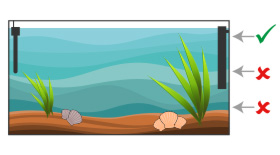
Top
Individuals
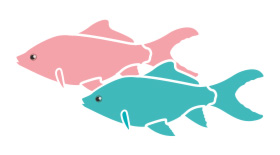
2
Food
How to feed the Gourami?
Food
How to feed the Gourami?
Omnivorous with insectivorous tendency. The gourami is easy to feed: it accepts all forms of food, such as pellets or flakes for carnivorous fish sold commercially. However, there is a preference for live prey or frozen (cyclops, artemia, vase worms, daphnia...). This will allow it to have varied menus.
Behavior
What kind of behavior does the Gourami have?
Behavior
What kind of behavior does the Gourami have?
The gourami is calm and slow by nature. Nevertheless, this species is one of the most virulent of its family. It can indeed be quite aggressive. This is especially true for young males who are more active and less peaceful, especially with other males of the same species.
It will spend the majority of its life in the upper part of the aquarium and will leave this area only during meals. It can then go to the lower part of the aquarium to feed.
Cohabitation
Who can live with the Gourami?
Cohabitation
Who can live with the Gourami?
It is strongly recommended to maintain a single male for a female (in trio, the female not chosen by the male will be constantly harassed by the couple).
Indeed, the males coexist very badly together, and will perpetually attack each other. For this duo / trio, it is necessary to provide an aquarium of at least 200 liters (50 gal).
It should also be noted that the shy nature of this species will prevent cohabitation with large fish. The gourami would then be frightened and then remain in a corner of the aquarium. Similarly, species too bright could disturb its tranquility.
So go for the smaller and calmer fish, and if possible those who live in a different aquarium area. Gouramis ignore other fish in the aquarium, so you can even associate small fish without risk. For example, the barbs will be an ideal candidate for cohabitation.
Coexistence with Corydoras is to be avoided for environmental reasons: Corydoras require a less planted aquarium, while Gouramis appreciate luxuriant vegetation.
Breeding
How to breed the Gourami?
Breeding
How to breed the Gourami?
For an effective breeding, put surface plants such as Pistias, Ceratophyllum demersum or even lentils. The Riccia fluitans will serve as a hiding place for fry.
In general, in the presence of other fish (even of their own species), the pair of Gourami Blue will refuse to breed. It will thus be necessary to isolate the couple in an aquarium specially prepared for their breeding. It can be an aquarium of 40 liters (10-11 gal) minimum, with a temperature of 25°C or 77°F. To trigger the breeding, increase the temperature by a few degrees (up to 28°C or 82°F maximum). The male will then build a bubble nest in which it will attract the female. The laying can include up to 2000 eggs!
After laying, remove the female and leave the male. The male will protect its nest and take care of it. It could then become aggressive with the female. After 4 to 5 days, the eggs hatch. When the fry begin to leave the bubble nest, remove the male.
For better efficiency, then lower the water level by 10 cm.
Feed the fry 3 to 4 times a day (the first week, if possible feed them once a night in low light, this will be a real plus for their growth). Keep a clean environment by changing 50 to 70% of the fry water weekly. As they grow, you can increase the nwater level.
Food for the fry: infusoria, then nauplies of artemia and bloodworms.
Its aquarium
Which aquarium for the Gourami?
Its aquarium
Which aquarium for the Gourami?
The Blue Gourami does not like the current. Be careful that the filtration system does not generate too much current, especially on the surface. To do this, aim the discharge rod as far as possible towards the wall of the aquarium so that the general current is not too strong. This will allow Trichogaster trichopterus to feel good in its tray.
The LowTech technique is therefore very much suited to this species.
Another important element to its well-being will be a densely planted aquarium, but with enough space to swim. For example, you can opt for a «C» shaped plantation. Floating plants (mixture of floating and Egeria, Cerato, Hydrocotyle that is allowed to float) will be required to provide the secure shade that this surface fish needs.
Good To know
Find all additional information!
Good To know
Find all additional information!
This species will be a very good choice for the novice aquarist: easy to feed, wide water parameters and easy cohabitation with many species.
The Gourami has the ability to breathe air on the surface if necessary (water slightly brewed and low oxygen). Indeed, it has a complementary respiratory organ called the Labyrinth. It acquired this faculty in its natural environment, where it lives in muddy waters.
With a little luck, you can watch the Gourami attack a mosquito on the surface and swallow it raw!
The Blue Gourami is available in many different shapes and varieties and colours:
- Silver Gourami
- Black Gourami
- Golden Gourami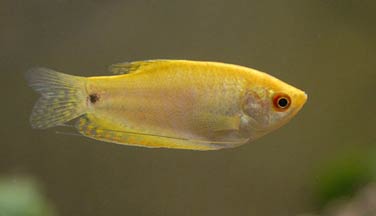
- Marbled Orange Gourami (this variety was born by chance in a summer pool among cosby-shaped fish)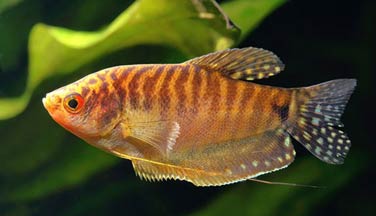
- Gourami Opaline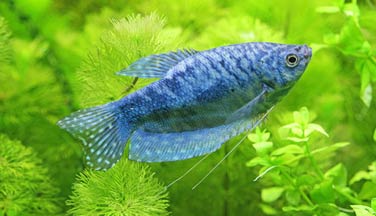
- Gourami Cosby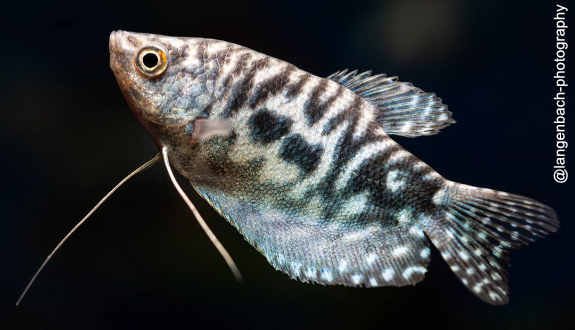
Yours photos!

By Encyclo-Caro
Comments
Sort by:
Please login to post comments
